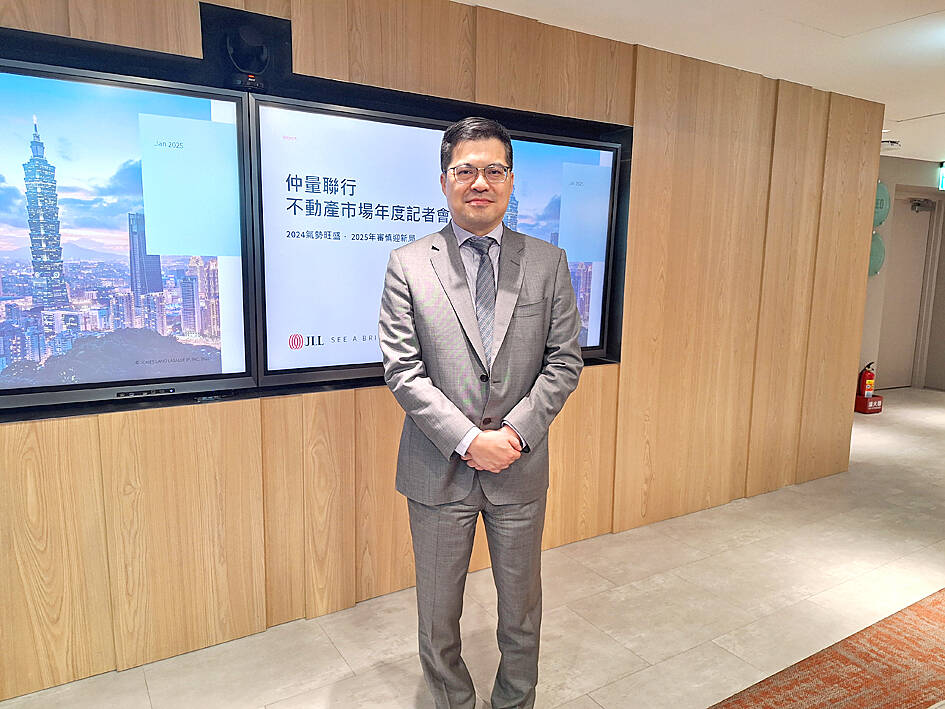Grade-A offices in Taipei last year saw the lowest vacancy rates in Greater China and ranked among the best effective rents in the Asia-Pacific region, helped by strong demand from technology and financial firms, property consultancy and broker Jones Lang LaSalle (JLL) Taiwan said.
Vacancy rates in Taipei’s core business districts hovered at about 5 to 10 percent, on par with Singapore, but lower than the average of above 10 percent seen in Shanghai, Beijing and Hong Kong’s Central District, JLL Taiwan managing director Kevin Hou (侯文信) told a media briefing on Thursday last week.
Taipei’s effective rent — the actual rent achieved by landlords after deducting renovation allowances, moving fees and other concessions — beat other first-tier cities in the region, including Tokyo, Hou said.

Photo: CNA
The figure represented the strongest in the post-COVID-19 pandemic era, although rental hikes showed signs of easing in the past two quarters, JLL Taiwan said.
Rent for the full year climbed 1.4 percent to NT$3,203 per ping (3.3m2), the smallest advance in three years, it said.
Rent hit NT$3,708 per ping in the city’s prime Xinyi District (信義) and averaged NT$2,616 and NT$2,546 in the Dunbei (敦北) and Dunnan (敦南) areas respectively, it said, adding that the average in Nangang District (南港) was NT$2,311.
Rent hikes moderated due to the entry of some large-scale office spaces into the market and growing uncertainty about the global economic outlook, Hou said.
As of Dec. 31 last year, the market had taken up 40 percent of the new supply, but there was still 17,000 ping of inventory to be digested, it said, adding that Nangang still had 7,000 ping left in inventory.
Vacancy rates are forecast to rise this year, with an additional 36,000 ping of Grade-A office spaces joining the market after stripping out and refurbishing some office buildings that were originally intended for self-occupancy, Hou said.
Rental rates are likely to slow further this year, as landlords offer concessions to woo corporate tenants, Hou said.
Companies at home and abroad are worried about US president-elect Donald Trump’s threats of tariff hikes after his inauguration next week and have become cautious about spending, he said.
Taipei would remain competitive going forward, with GDP forecast to grow 3.13 percent this year, faster than in Singapore, Hong Kong, South Korea and Japan, said Sherry Wu (吳瑤華), a senior property investment analyst at JLL Taiwan.
The growth forecast suggests a deceleration from last year’s 4.25 percent increase, but remains resilient, Wu said.

Taiwan’s long-term economic competitiveness will hinge not only on national champions like Taiwan Semiconductor Manufacturing Co. (TSMC, 台積電) but also on the widespread adoption of artificial intelligence (AI) and other emerging technologies, a US-based scholar has said. At a lecture in Taipei on Tuesday, Jeffrey Ding, assistant professor of political science at the George Washington University and author of "Technology and the Rise of Great Powers," argued that historical experience shows that general-purpose technologies (GPTs) — such as electricity, computers and now AI — shape long-term economic advantages through their diffusion across the broader economy. "What really matters is not who pioneers

In a high-security Shenzhen laboratory, Chinese scientists have built what Washington has spent years trying to prevent: a prototype of a machine capable of producing the cutting-edge semiconductor chips that power artificial intelligence (AI), smartphones and weapons central to Western military dominance, Reuters has learned. Completed early this year and undergoing testing, the prototype fills nearly an entire factory floor. It was built by a team of former engineers from Dutch semiconductor giant ASML who reverse-engineered the company’s extreme ultraviolet lithography (EUV) machines, according to two people with knowledge of the project. EUV machines sit at the heart of a technological Cold

TAIWAN VALUE CHAIN: Foxtron is to fully own Luxgen following the transaction and it plans to launch a new electric model, the Foxtron Bria, in Taiwan next year Yulon Motor Co (裕隆汽車) yesterday said that its board of directors approved the disposal of its electric vehicle (EV) unit, Luxgen Motor Co (納智捷汽車), to Foxtron Vehicle Technologies Co (鴻華先進) for NT$787.6 million (US$24.98 million). Foxtron, a half-half joint venture between Yulon affiliate Hua-Chuang Automobile Information Technical Center Co (華創車電) and Hon Hai Precision Industry Co (鴻海精密), expects to wrap up the deal in the first quarter of next year. Foxtron would fully own Luxgen following the transaction, including five car distributing companies, outlets and all employees. The deal is subject to the approval of the Fair Trade Commission, Foxtron said. “Foxtron will be

INFLATION CONSIDERATION: The BOJ governor said that it would ‘keep making appropriate decisions’ and would adjust depending on the economy and prices The Bank of Japan (BOJ) yesterday raised its benchmark interest rate to the highest in 30 years and said more increases are in the pipeline if conditions allow, in a sign of growing conviction that it can attain the stable inflation target it has pursued for more than a decade. Bank of Japan Governor Kazuo Ueda’s policy board increased the rate by 0.2 percentage points to 0.75 percent, in a unanimous decision, the bank said in a statement. The central bank cited the rising likelihood of its economic outlook being realized. The rate change was expected by all 50 economists surveyed by Bloomberg. The